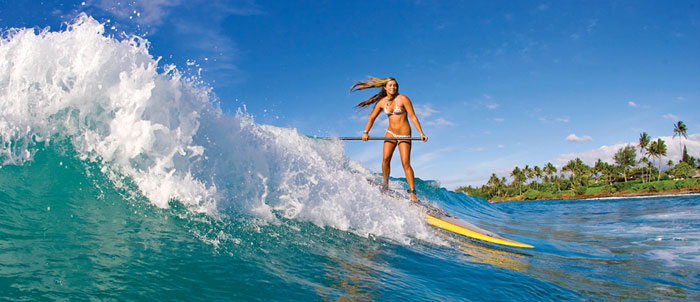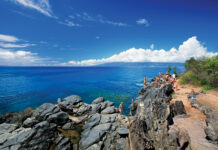Story by Catharine Lo | Photo by Naish/Eric Aeder
 Fourteen years ago, Dave Kalama and Laird Hamilton were on a photo shoot at Ma‘alaea on Maui’s south shore, brushing up on their longboarding style on the waves outside the harbor. The surf was small—a kiddie pool for the renowned big-wave surfers—so on a lark, Kalama grabbed his outrigger canoe paddles, and the two watermen made up a game, using the short blades to propel their twelve-foot boards into the breakers while standing upright. They looked kind of goofy hunched over, taking fast, punchy strokes without a canoe, but they had so much fun that Hamilton made some longer paddles the very next day.
Fourteen years ago, Dave Kalama and Laird Hamilton were on a photo shoot at Ma‘alaea on Maui’s south shore, brushing up on their longboarding style on the waves outside the harbor. The surf was small—a kiddie pool for the renowned big-wave surfers—so on a lark, Kalama grabbed his outrigger canoe paddles, and the two watermen made up a game, using the short blades to propel their twelve-foot boards into the breakers while standing upright. They looked kind of goofy hunched over, taking fast, punchy strokes without a canoe, but they had so much fun that Hamilton made some longer paddles the very next day.
Standup paddling, often referred to by its acronym, SUP, is now a rapidly growing sport that combines two of Hawai‘i’s signature ocean activities, surfing and canoe paddling. It also incorporates aspects of traditional paddleboarding, the distance sport that employs a narrow board similar to those used for windsurfing, powered by the paddler’s arms as he or she lies prone or kneels on the board. Maneuvering while standing, though, feels more natural, and for nonsurfers, is easier to learn.
SUP enthusiasts say gliding across a vast, uncluttered liquid arena using only a board and a paddle is liberating. A little tailwind can take you on an exhilarating ride for miles. In calm, clear water, you can watch fish and turtles swim around the reef. For some aficionados, standup paddleboarding is an appealing core workout. For me, it’s about finding a small crinkle in the cerulean crepe-paper sea where I can fall into the rhythm of nature. The ocean seems oblivious to my presence, and I get lost in the perpetual transformation of waves as crest meets trough meets crest meets trough.
The placid nature of floating on flat water has an intrinsic appeal to casual paddlers, who commonly describe it as “taking a walk on the ocean.” Since no waves are required, people who live nowhere near the ocean have begun to embrace standup paddling, introducing the sport to lakes and rivers where no surfboard has been before.
But it didn’t take long for wave-riding adrenaline junkies to realize the sport’s versatility. While flat-water paddlers use the paddle primarily as a gas pedal, standup surfers use it to navigate, accelerate, turn, and balance. By planting the blade in the water while riding, surfers create a point around which they can pivot, allowing them to carve stylish turns along the wave face.
Maui surfers benefit from the island’s notorious wind and consistent waves, picking their playground as conditions vary. Local paddlers venture down streams, around bays, along coastlines, and even across channels.
“The possibilities are endless,” says Michi Schweiger, a competitive SUP paddler and a product manager for Naish Sails Hawai‘i, one of Maui’s leading suppliers of standup-paddleboarding equipment. “If it’s windy, the downwind run from Maliko to Kahului is epic.” If the wind isn’t blowing, he adds, there are rideable surf spots on both the north and south shores. Plus, SUP paddlers can get to outer reefs too far for prone surfers to access.
“When you catch waves out there, it is a great feeling,” Schweiger says. “You are in the middle of the ocean, watching the sets come in and pass by. The waves break on the shallow reef, and the spray goes up several feet into the air. Haleakal¯a is in the background—hard to beat. You see the island with different eyes when you can look back at it from the ocean.”
Standup paddling is actually a modern revival of a board-riding technique put into practice by the Waikïkï beach boys in the 1960s. The good-time surf instructors used to steer their heavy planks with canoe paddles, a less strenuous alternative to prone paddling that also made it easier to take photos of their students.
While the beach boys used their standup boards for functional purposes, today’s paddlers have taken to racing their boards. In recent years, Dave Kalama has established himself as an elite standup paddler. He and his cousin Ekolu have won the team relay in the Moloka‘i Paddleboard Race—thirty-two grueling miles from Moloka‘i to O‘ahu—three years running, and they hold the SUP course record of four hours, thirty-six minutes, fifty-five seconds. Kalama has also been beta-testing performance surfboards, which are shorter and more tapered than standard SUP boards. Negotiating the waves with a paddle and a maneuverable board, he says, can turn ho-hum surf into extraordinary fun.
Kalama attributes much of his SUP prowess to the water knowledge derived from big-wave riding and outrigger paddling. He’s not alone.
“The training of outrigger paddling helps me with technique big time, and the experience of big-wave riding teaches me how to read the ocean swell,” says Andrea Moller, one of Maui’s leading waterwomen. Moller and her big wave tow-in partner, Maria Souza, became the first females to traverse the Kaiwi Channel on SUP boards, winning the women’s team relay in the 2005 Moloka‘i Paddleboard Race, a title Moller has retained ever since. (Visit www.hawaiipaddleboardassociation.com for 2009 race results.) Gliding on trade-wind-generated swells and connecting them “bump to bump” across the open ocean is like “surfing a never-ending wave,” she says.
Moller, who has a six-year-old daughter and multiple work obligations, appreciates the easy escape that paddling offers. Recently, she and several friends journeyed around Maui’s rugged northwest coast from Maliko to Lahaina on SUP boards. “I love the fact that you can go to the other side of the island on a standup board,” she says. Such excursions speak to her philosophy: “Life is short, and the ocean can give a lot of happiness.”
Where distance is concerned, SUP paddlers are also raising the bar: It was 2006 when Laird Hamilton solo paddled forty-three kilometers across the English Channel. Earlier this year, John Hibbard and Anthony Cooper tamed the Thames River, traveling 125 miles from Devizes to Westminster.
Besides its uncontrollable-wide-grin fun, SUP’s social adaptability also fuels its popularity. Moller reasons that since it’s a less intimidating sport than surfing—and one not dominated by men—females have embraced it with their own style. Clusters of women are often seen cruising on SUPs, a happy hour of the ocean-rec variety. Parents paddle with their toddlers on the noses of their boards. Guys are even inviting girls on standup “dates.”
“I’m sure this sport will provide the opportunity to travel to places we haven’t been, meet people we haven’t met, and do things we never thought we could do,” Kalama says. “It has already given these things and much more.”
Size Matters
Standup boards come in a variety of shapes and sizes, typically ranging from ten to sixteen feet. All-purpose cruisers are wide; beginners should look for something around thirty inches, which assures stability. Downwind boards are longer and narrower, designed for greater hull speed, and some even have rudders. Surfing boards are shorter and more tapered to enhance maneuverability. It’s a good idea to rent boards initially to figure out what you’re most comfortable standing on.
For more information:
Hawaiian Island Surfboards
mauisurfshop.com, 800-231-6958
Hi Tech Surf Sports
surfmaui.com, 877-2111
Lightning Bolt Maui
lightningboltmaui.com, 877-3484
Naish Maui Pro Center
naishmaui.com, 871-1500
Stand-up Paddle Surf School
standuppaddlesurfschool.com, 579-9231
Avoiding Surface Tension
As more standup paddlers hit the water, the need for etiquette grows. SUP surfers who encroach on traditional surf lineups have stirred resentment in the water. “It’s vital that everyone is respectful toward one another,” says Dave Kalama.
Here are some guidelines:
1. Do not approach a surf lineup until you have mastered your equipment. Until you have full control over your board and your paddle, practice in empty surf.
2. Don’t hog the waves. Just because you can catch them further out doesn’t mean you should take as many as you want. Wait your turn, and give waves away.
3. Alert prone surfers to incoming sets (and, of course, to threatening marine life).
4. Seek surf breaks on outer reefs where prone paddlers don’t go.
5. During a lull, sit down so you don’t tower over everyone else. Be friendly!





